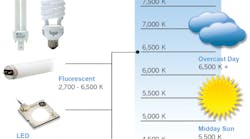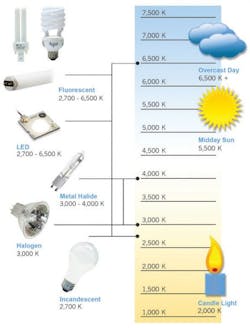It’s no secret the cost of electrical energy continues to rise and will inevitably continue to do so in the future. At the same time, the demand for electricity continues to increase, taxing our existing electrical infrastructure to the margins of their design limits. We need more power, but in order to get it, we need new transmission and distribution infrastructure — but that’s just the beginning.
Efficiencies need to improve. Smart grid and microgrid strategies need to be deployed, and energy storage needs to be maximized. The list goes on and on. The problem is all of these propositions require a large amount of capital, which seems to be in short supply these days. Therefore, the quickest and least expensive way to generate more electricity is to not consume it in the first place. One way to use less energy is to install newer and more energy-efficient lamps, luminaires, and controls. Even lighting systems that were deployed just five years ago could benefit from newer lighting technologies and/or better control strategies.
The U.S. Energy Information Administration (EIA) estimates that about 461 billion kWh of electricity were used for lighting by the residential and commercial sectors in 2011. This was equal to about 17% of the total electricity consumed by both of these sectors and about 12% of total U.S. electricity consumption. Residential lighting consumption was about 186 billion kWh — or 13% of all residential electricity consumption. The commercial sector, which includes commercial and institutional buildings and public street/highway lighting, consumed about 275 billion kWh for lighting — or 21% of commercial sector electricity consumption in 2011.
The good news is lighting has become more efficient over the last decade and continues to evolve. Not only have lamps and luminaires become more efficient, but so have lighting control systems. Installing new luminaires and lamps — or retrofitting existing luminaires and lamps — is standard practice for the electrical industry. However, installing lighting controls to save energy has sent many electrical contractors and technicians back into training mode.
Lamp/luminaire and lighting control strategies are driven by the need to save energy and by the adoption of energy codes like the International Energy Conservation Code (IECC), ASHRAE/IESNA 90.1, or state standards like California’s Title 24. As lamp efficacies improve, energy codes are driving down the number of watts per square foot used to light any give space within a building. Add in effective lighting controls, and you can drive down energy consumption even further. On the voluntary side, the Leadership in Energy and Environmental Design (LEED) certification program, developed by the U.S. Green Building Council (USGBC), has had a profound impact on driving energy-efficient lighting design as well.
There are other benefits for installing a well-engineered lighting system. Although the following benefits may appear to be less quantifiable, in reality, they are no less important than saving energy. First is the effect that a lighting system has on improving the productivity, recruitment, and retention of the customer’s employees. The second is green and zero net energy branding opportunities. A 2009 research study, “Green Goes Mainstream: How to Profit from Green Market Opportunities,” authored by Jerry Yudelson, Yudelson Associates, Tucson, Ariz., found an average 3.2% increase in productivity from lighting improvements. The same study also revealed that a 1% increase in productivity equates to 100% reduction in energy costs.
Lamp and luminaire choice is usually driven by customer request in consultation with an architect, lighting designer, or both to meet occupancy requirements. However, in some cases, the electrical contractor may become the specifier of the lamps and luminaires to reduce costs for the customer (value-engineering). Electrical contractors involved in design/build projects have greater influence over lighting selection. Because most design/build electrical contractors are not lighting designers, learning something about basic lighting design benefits everyone involved.
Just like the lighting designer, the electrical contractor needs to understand the customer’s lighting requirements. In the case of value-engineering or design/build scenarios, realize that the customer may be relying on your expertise when it comes to lamp/luminaire selection, layout, and control. Some basic questions to ask the customer include: What is the major task(s) that will be performed in the space (e.g., task lighting)? What surfaces or objects need to be lit (e.g., focal lighting)? What types of fenestrations will the space contain (e.g., daylighting)? Is any lamp/luminaire going to be used as an architectural or decorative feature (e.g., decorative lighting)? What is the mood of the space, or what are the navigation requirements within the space (e.g., ambient lighting)? In some designs, energy savings and increased productivity may be gained by separating task lighting from ambient lighting and using innovative control strategies.
The proper selection of the lamp and luminaire begins with understanding something about the qualities of a light source, which are determined by the method used to produce the light. Light sources range from incandescent and halogen to fluorescent and HID to light-emitting diodes (LEDs). Lamps are rated in lumen output, watts, and lumens per watt or efficacy. Lumen output is the total light output of the lamp. This does not include fixture lumens only lamp lumens. (It’s important to understand the difference when evaluating LED lamps and luminaires.) Efficacy is the measure of how efficient one light source is when compared to another. The more lumen output per watt of power consumed, the more efficacious the lamp is. When purchasing lamps, think lumens, not watts.
The quality of light is also a measure of its color accuracy and the color of the light itself. Color accuracy is a measure of how well the light source can render the colors of an object. This is known as the color rendering index (CRI), which is measured on a scale of 0 (very poor rendering) to 100 (perfect rendering). The color of the light the lamp produces (whether the light appears warm, neutral, or cool) is a function of its color temperature. The lower the color temperature, the warmer (more red) the lamp appears; the higher the color temperature, the whiter or cooler the light source appears (more blue). This is known as the correlated color temperature (CCT), as shown in the Figure.
Other areas of concern when selecting a lamp are its operating temperature range, lamp life, lumen maintenance (how much light output diminishes over the life of the lamp), directionality, dimmability, starting time, and life-cycle costs. All lamp qualities need to be understood to provide the customer with the desired end result. This implies that you, as the electrical contractor, understand how all lamps generate their light and what their operational characteristics are. Control strategies will be predicated on the operational characteristics of the lamp and occupancy requirements.
The goal is to have a better understanding of the nature of light — not necessarily to become a lighting designer. However, if you are providing design/build services or value-engineering a lighting system, understanding some basics of lighting design will help a great deal. Many lighting and lighting control manufacturers provide basic online training with regard to understanding the nature of light, lamp characteristics, luminaire selection, and the correct switching or dimming control devices and topologies. Many lighting manufacturers also offer webinars and training courses, some of which are free. Staying on top of the latest training resources in the lighting arena will go a long way toward maximizing your next energy-efficient installation.
Coleman is a director of telecommunications curriculum development and training with the National Joint Apprenticeship and Training Committee based in Upper Marlboro, Md. The NJATC is the training arm of the International Brotherhood of Electrical Workers and the National Electrical Contractors Association. He can be reached at [email protected].




